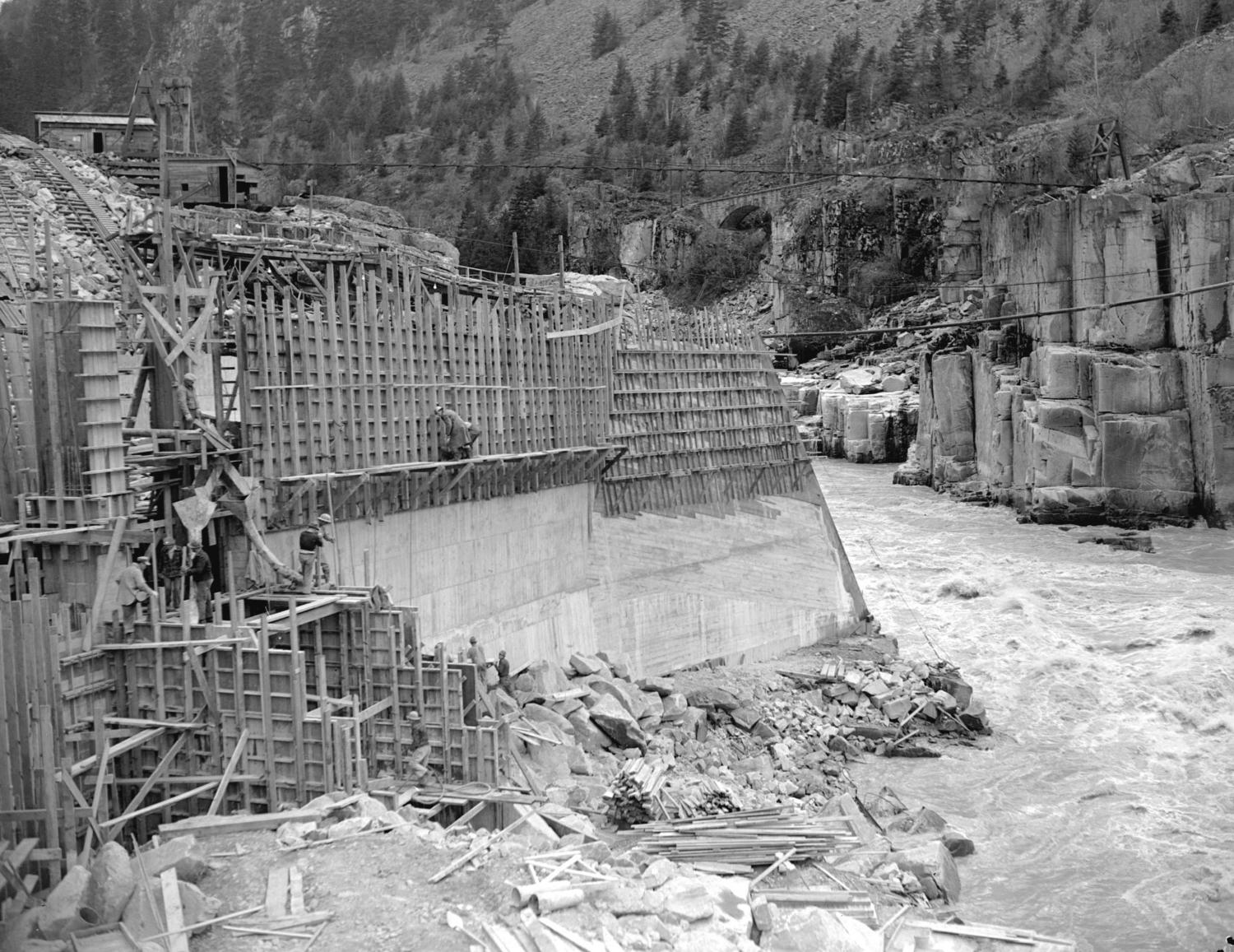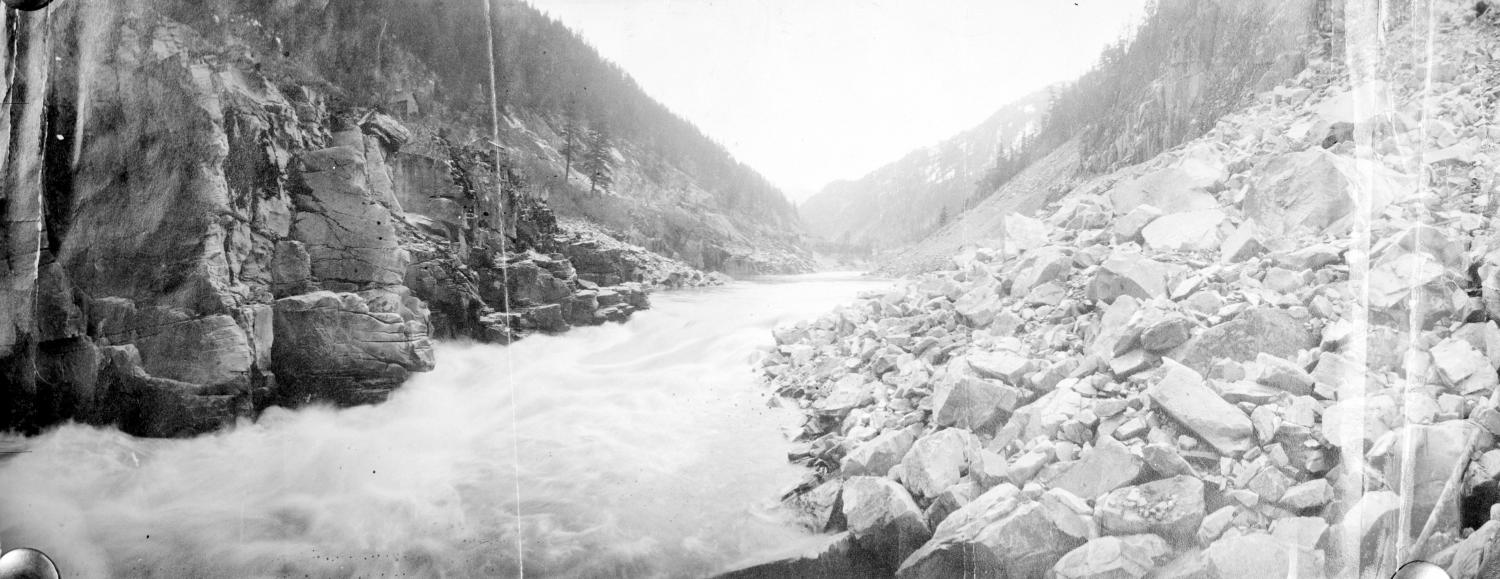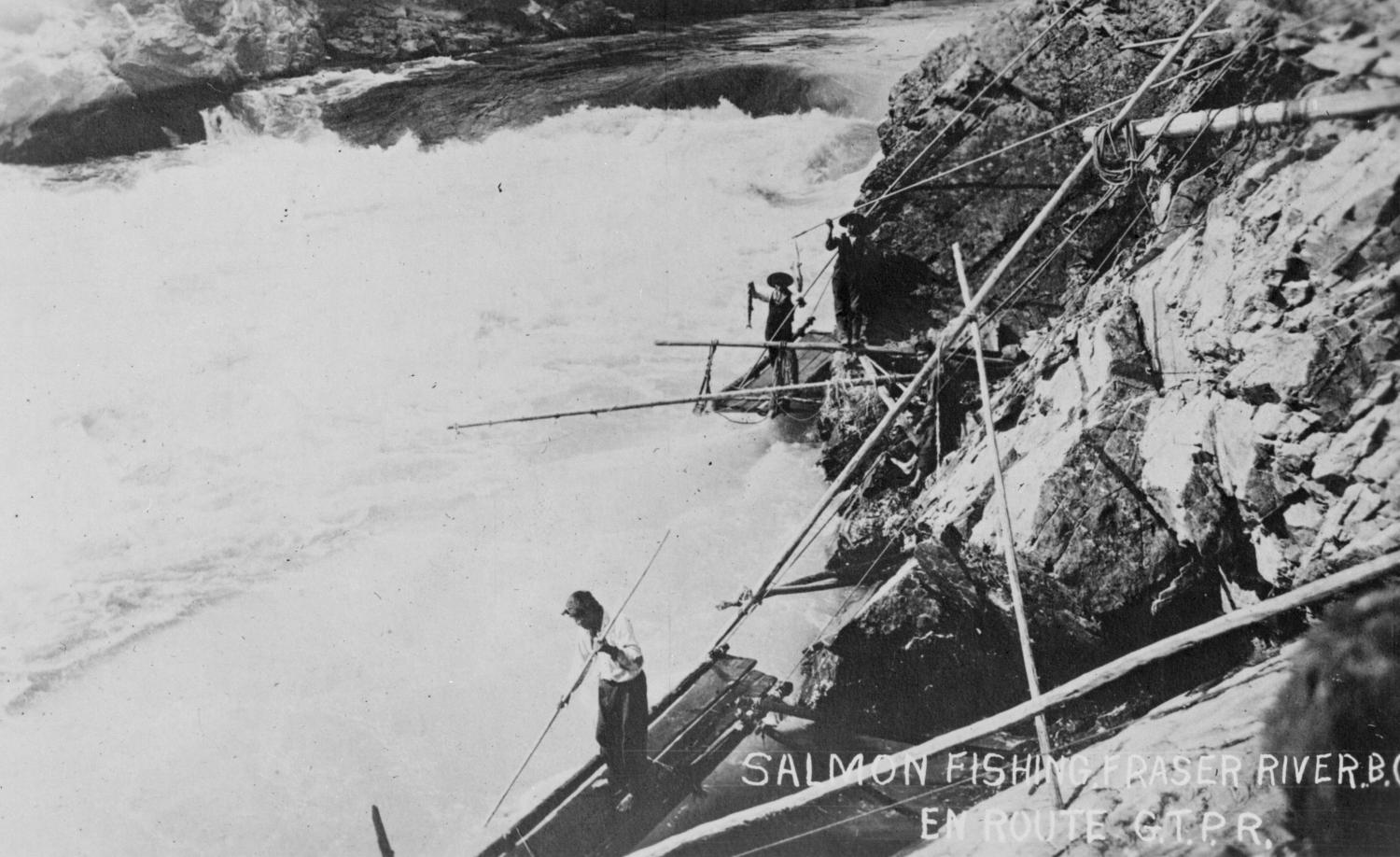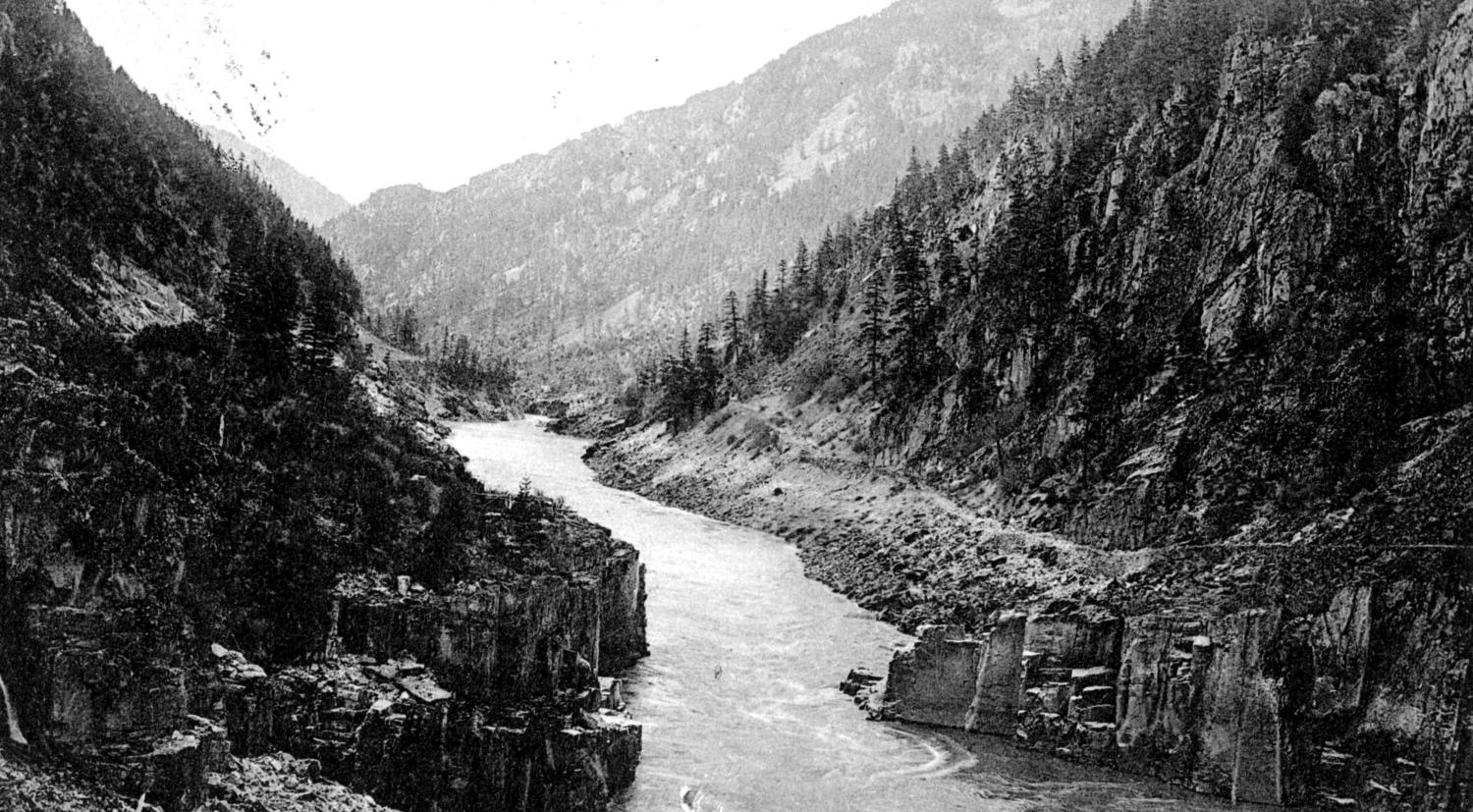The Hell's Gate Landslide
Railroad construction causes a landslide that blocks millions of spawning salmon
Date: 1914
For thousands of years, an annual pilgrimage took place in the Fraser River. Tens of millions of salmon of various species would swim to their spawning grounds. In the summer, the Fraser would fill with wriggling bodies and flashes of colourful scales. For the Nlaka’pamux and Stó:lō First Nations who historically lived upstream, the salmon were — and remain — a life-sustaining source, a staple of their economy and cultural beliefs. As Europeans arrived in the area, they, too, would rely on the bountiful supply of fish for food and as goods to sell.
In close to 1,400 kilometres of river, the most perilous point in a salmon’s journey was crossing Hell’s Gate. It was the Fraser’s narrowest point, where the steep walls of the gorge funnelled water into swift, choppy rapids.
In the early 20th century, work crews arrived at Hell’s Gate to build the Canadian Northern Railway. The terrain was precarious for the workers, who were pressured into hasty and reckless construction by the cash-strapped railway company. To lay track, workers had to blast heavy rock with explosives, sending debris tumbling into the waters below. At first, the blasts were unremarkable, and the falling rock easily dismissed. A small landslide in the summer of 1913 was cause for some concern, but on Feb. 23, 1914 — months after the railway crew had left — 100,000 cubic yards of loosened granite would plunge into the Fraser. The force of the water now gushed through what had become of the river: a 23-metre channel. The rockfall had “practically formed a dam,” wrote the federal chief inspector of fisheries. “One might say that the whole character of the river at this point is changed.”
While work began to remove the rubble the following month, it was unfinished when salmon arrived at the beginning of July. Local Indigenous men were hired to transfer the fish over to the other side with nets — but it wasn’t enough. The salmon numbers were dismal. This was devastating for the Indigenous communities dependent on salmon to survive. Within a year, an estimated 20 per cent of the nearby First Nations population would starve or die from malnutrition. Tight restrictions imposed by a panicked government would only make matters worse. Almost immediately, the government banned net-fishing in inland waters, targeting Indigenous fisheries. Later, it would outright ban First Nations from fishing between Hope and Lytton, even as non-Indigenous commercial fisheries remained open downriver.
In the years after the slide, workers would continue to remove rock and debris. But the damage had been done. Salmon numbers were a fraction of what they once were — and would stay that way for decades.
In 1937, Canada and the United States formed the International Pacific Salmon Fisheries Commission (IPSFC) to address the declining salmon returns. By 1945, the IPSFC had constructed giant concrete “fishways,” transporting the salmon around the obstruction at Hell’s Gate. Recovery was further assisted in 1985 with the addition of artificial spawning channels. By 1990, the sockeye and pink salmon numbers had largely recovered, reaching more than 80 per cent of their numbers before the 1914 rockslide.
This success remains tenuous, though. While their numbers are up, the salmon population has yet to rebound fully, and natural landslides remain a threat. In 2018, a massive slide occurred north of Lillooet, significantly reducing the following year’s salmon run. Nevertheless, the salmon still come. Over half of all salmon harvested in the province now takes place in the Fraser River watershed. The fish remains important, economically and culturally, for the Indigenous people along the Fraser River Basin — including the Nlaka’pamux, Okanagan, Stl’atl’imx, Secwepemc, Wet’suwet’en, Sekani, Dakelh, and Ts’ilhqot’in — who have fought relentlessly for the fish’s conservation.
Sources:
1. “100th Anniversary of the Hell’s Gate Rockslide.” Watershed Talk Newsletter, Fraser River Aboriginal Fisheries Secretariat, 26 Aug. 2013, www.frafs.ca/.
2. Aboriginal Fisheries in British Columbia. First Nations and Indigenous Studies at the University of British Columbia, indigenousfoundations.arts.ubc.ca/aboriginal_fisheries_in_british_columbia/.
3. BC Highway History: Alexandria Bridge and Hell's Gate. TransCanada FoundLocally Inc., transcanadahighway.com/british-columbia/bc-tch-history/highway-history-alexandra-bridge-and-hells-gate/.
4. Evenden, Matthew. Remaking Hell's Gate: Salmon, Science, and the Fraser River, 1938-1948. BC Studies, Autumn 2000, ojs.library.ubc.ca/index.php/bcstudies/article/download/1538/1581/.
5. Grant, S.C.H., et al. Evaluation of Uncertainty in Fraser Sockeye (Oncorhynchus Nerka) Wild Salmon Policy Status Using Abundance and Trends in Abundance Metrics. Fisheries and Oceans Canada, 2011, www.dfo-mpo.gc.ca/csas-sccs/publications/resdocs-docrech/2011/2011_087-eng.html.
6. Hammond, Joanne. “Dig It: Salmon below the Slide through the Ages.” Kamloops This Week, 1 Oct. 2019, www.kamloopsthisweek.com/community/dig-it-salmon-below-the-slide-through-the-ages-1.23962899.
7. Hell's Gate History. Hell's Gate Airtram, www.hellsgateairtram.com/about/history/.
8. “Hells Gate Slide.” From Tides to Tins, Virtual Museum of Canada, 19 July 2020, tidestotins.ca/event/hells-gate-slide/.
9. Hernandez, Jon. Majority of Early Fraser River Sockeye Run Won't Make It to Spawning Grounds, Report Suggests. CBC News, 26 July 2020, www.cbc.ca/news/canada/british-columbia/majority-of-early-fraser-river-sockeye-run-won-t-make-it-to-spawning-grounds-report-suggests-1.5663356.
10. Hobbs, William O., and Alexander P. Wolfe. Recent Paleolimnology of Three Lakes in the Fraser River Basin (BC, Canada): No Response to the Collapse of Sockeye Salmon Stocks Following the Hells Gate Landslides. Springer Science+Business Media, 2007, faculty.eas.ualberta.ca/wolfe/eprints/Hobbs%26WolfeJOPL.pdf.
11. Our History. Pacific Salmon Commission, www.psc.org/about-us/history-purpose/our-history/.
12. Saxvik, Per. Geographical and Historical Background. Fish Passage Structures on the Fraser River, www.saxvik.ca/pages/frameset.html.
13. The Stó:Lō “People of the River.” Mission Museum, 30 Sept. 2020, www.missionmuseum.com/local-history/stolo/.





